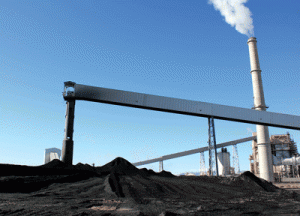By VERNON ROBISON
Moapa Valley Progress

Though they might not be aware of it, local residents have been witness to the farewell voyage of one of the community’s most important industrial facilities over the past month. This week the Reid Gardner Power Plant in Moapa is entering, what will probably be, its final month of operations.
Throughout the month of January, the plant has been running at full load capacity 24 hours per day. This is expected to continue until the coal inventory piled up in the yard at the plant is entirely spent. With about 90,000 tons of coal left on hand; and the plant burning 2,800 tons per day; the end is expected to come around the last day of February. At that point, the coal burning plant will fall silent for good.
Reid Gardner has been in service for more than 50 years now. The first unit at the plant began operation back in 1965. Three years later, a second unit, identical to the first, was launched. A similar unit was added in 1976. These three generating units together produced about 300 megawatts of power at their peak. The plant’s final generating unit, Unit 4, was commissioned in 1983. This unit, much larger than the others, has a capacity to produce 257 megawatts of power.
As originally designed, the plant was meant to run round the clock providing baseload power for the region. But in recent years, that function has changed. As the price of natural gas has dropped, and costs of environmental regulations have mounted, the facility has reduced its operations to times when there is a peak demand for energy. Thus, staff at the plant have become accustomed to firing up the plant when power was needed, and shutting it down again when it was not.
Over the years, Reid Gardner has been faced with constantly changing environmental regulations. Each of these regulations have aimed to clean up the effects that coal burning plants have on the air and the water.
During the late 2000s, NV Energy poured millions of dollars into technology to improve emissions at the plant. Systems were installed to reduce the amount of nitrous oxide emissions. Baghouses were installed to capture more than 99 percent of particulate emissions. And the plant was retro-fitted with natural gas igniters discontinuing the need to burn diesel oil at plant start-up.
All of these efforts combined brought a marked improvement to the plant’s environmental footprint. Reid Gardner was recognized as being on the cutting edge of emission control technology and as one of the cleanest burning coal plants in the country.
But in 2013, the focus changed. By that time NV Energy had become a part of Berkshire Hathaway Energy, a company known for its focus on developing sources of renewable energy.
Conditions had also changed at the state capital. In 2013, the Nevada Legislature passed landmark legislation called Senate Bill 123. This bill required a major reduction of coal-fueled generation in the state by 812 megawatts. This huge block of coal-generated power was to be replaced by renewable energy and natural gas resources. While the bill did not mention Reid Gardner specifically, it did call for all coal-fueled capacity in southern Nevada to be shuttered by 2019.
This focus at Reid Gardner immediately shifted to developing a schedule for decommissioning the plant. Units 1, 2 and 3 were shut down and disconnected from the grid at the end of 2014. Unit 4 was originally scheduled to be decommissioned at the end of 2017. But last year, NV Energy petitioned the state Public Utilities Commission (PUCN) for an early shut down of the plant.
“That request was really to the benefit of the customer to retire Unit 4 early,” Hammons said. “It just made more sense economically and from an operations standpoint.”
The request was approved by the PUCN toward the end of December. The unit was then brought back online on January 3 to begin its final swan song. It is expected to run continuously now to burn through its remaining coal inventory.
“We are forcasting to be basically out of coal by roughly the end of February,” Hammons said. “At that time, we will be transitioning employees either to other facilities in southern Nevada, or to the demolition project of this facility.”
In fact, the reduction in workforce at Reid Gardner has been going on for several years now. At its heyday, the plant employed around 170 people. By 2014, when Units 1, 2 and 3 went down, there were 65 employees left at the plant. Today the facility is down to a force of about 43 employees. And by the end of the year, only around 20 are expected to still be working on site, Hammons said.
“The good message on this is that we have not laid off any employees through this process,” Hammons said. “We have been able to transition all of our people to other sites with the company.”
Many of those transitions are being made to a trio of NV Energy power generating facilities in the Apex Industrial park area called the Arrow Canyon Complex. That’s where most of the former Reid Gardner employees have gone, Hammons said.
“Most of the foks that live here in the valley have remained living here,” Hammons said. “A good portion of them have transitioned over to our Arrown Canyon Complex right there near the Love’s turnoff of I-15. So they have remained here in the valley because the commute is not bad. That’s why we really haven’t seen a lot of people relocate or sell their homes and move away.”
For the few that are left on staff at Reid Gardner, there will be plenty to do over the next year or so. After the final shutdown, the process of disconnecting and dismantling the complex network of systems at the plant will begin.
During that process, any equipment or components that can be used at other NV Energy facilities will be transferred. A contractor will then be hired to try and broker the sales of other components and parts that cannot be transferred to other facilities. Finally, whatever remains will be left to the demolition contractor to sell as scrap or otherwise dispose of.
Hammons said that the demolition would take 18-24 months to complete. He expected that the four smoke stacks, that are the most recognizable part of the plant, would be the last to come down.
“Of course, it is up to the discretion of the demo contractor,” he said. “But I would think that they would have the whole area cleared out around where those stacks will come down. Then the stacks will probably be the last things to come down.”
Of course, clearing away the buildings at the plant is only a part of the full reclamation of the site. There is a much more involved, and longer lasting, process ongoing for environmental mitigation of the property. Overseeing all of that will be Matt Johns, a Director of Environmental Remediation at NV Energy.
Johns said that testing and study on soils and ground water at the site has been underway for quite some time already. When Units 1, 2 and 3 were decommissioned, several buildings were demolished at that time including cooling towers and maintenance shop facilities.
“That allowed us to do some environmental work underneath those buildings and around them,” Johns said.
Soil samples were taken to determine if there were petroleum impacts on the ground in the area.
“At the vehicle maintenance building, for example, there was 40 years of oil changes and equipment work done,” Johns said. “So we are looking for petroleum impacts in those areas. We did some excavations in 2015 to clean up those areas and remove petroleum impacted soil.”
That soil was taken to the Apex landfill for disposal, he said.
The company is also performing a number of efforts to understand and mitigate any groundwater impacts in the area. Involved with that is the removal and reclamation of the remainder of the settling ponds at the plant. The company has closed seven ponds already, but there are four still remaining to close down and clean up. All of those ponds will be closed down by the end of this year, Johns said.
The reclamation process involves allowing the water in the ponds to evaporate, and the area to dry out over a period of time. This leaves a thick deposit of dry solids, waste products from the coal-burning plant, sitting atop a heavy material that lines the large ponds. Contractors then come in with heavy equipment and remove the solids from the site, disposing of them at the a permitted landfill on site just south of the plant.
After the solids are gone, the pond liners are also removed. Then samples are taken of the soil that was underneath the liners to ensure that none of the solids have leached through the liner.
Finally, the company has instituted a complex site monitoring program for groundwater. This program involves around 100 monitoring wells, at a depth of 100 feet, to test ground water and determine any impacts.
“We are doing a lot of studies right now to understand the groundwater conditions and to evaluate water and soil impacts,” Johns said. “We have had significant efforts in drilling and testing and understanding the geology of the subsurface. We are right in the middle of that right now and it will probably be a year or so before we get a full understanding of the site conditions.”
Once they have that understanding, the data will provide a path to knowing what remediation steps need to be taken, Johns said.
The end goal is to leave the site in as “natural” a state as possible. Plant facilities are removed, soil returned to normal, settling ponds reclaimed and finally the landfill will be capped with a cover system and the surface returned to a natural state, Johns said.
“Of course, we recognize that there will be some facilities that will be needed to fulfill the long-term environmental obligations to the site,” Johns said. “So there will still be some site management and monitoring for a long time to come.”








![ElectionAd [Recovered]2](https://mvprogress.com/wp-content/uploads/2024/05/4-24-2024-FC-ElectionAd-Finalv3.jpg)

